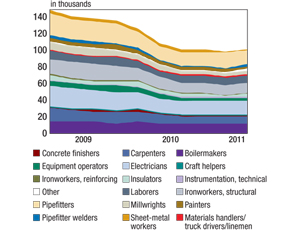The Construction Users Roundtable will be helping the industry forecast labor supply and demand with a Web-based data-collection and forecasting tool. Owners and contractors who enter data will be able to run forecasts at no charge. The tool is a result of an initiative, commissioned by CURT, and managed by the non-profit Construction Workforce Development Center. About 50 owners have been using the database and inputting demand-side project data since February. The supply side of the model launched in mid-June, and 27 contractors have input craft labor availability data, according to CURT’s workforce consultant, Daniel Groves. The model is available at www.cwdcforecasting.com.
To address potential user concerns about data security, the model has “strong confidentiality and antitrust protocols,” says Groves. “Project data is visible to the user only and outputs are aggregate information, so no individual project or owner is ever revealed.” Craft labor demand is not everyone’s top concern now, Groves acknowledges. But using this database will allow owners, contractors and labor groups to be prepared as construction rebounds, he adds.

TYLER
This initiative was among a number of industry bright spots discussed at the ENR-CURT Construction Business Forum in Arlington, Va., on June 9-10. Another one was military construction activity and the boost it is getting from the American Recovery and Reinvestment Act—even beyond the “historically large” programs of the past three years, said J. Joseph Tyler, director of military programs for the U.S. Army Corps of Engineers. For fiscal 2009, the Corps will spend $7.5 billion for civil-works construction and $25 billion for military construction.
Indicative of the times, there has been “unbelievable competition for our bids,” Tyler said, predicting fewer cost-plus contracts and more firm fixed-price work in the future. He noted that in the Corps’ effort to keep up with the work, it will be recruiting for about 3,000 positions.
ARRA funding is an issue of “velocity—we were doing good work, and now we are going to do it faster,” said Chuck Hardy, a deputy director in the Great Lakes Region for the U.S. General Services Administration. He added that GSA work will include both construction and design contracts with an emphasis on high-performance green buildings. With $5.5 billion of recovery funds, “we have to quickly but deliberately plan how we want to go forward. Contracts are flowing right now...and additional contracts will be let in all portions of the industry,” Hardy said.

HARDY
The event also addressed energy infrastructure, and speakers were optimistic that the long-heralded “nuclear renaissance” in the U.S. may be closer to reality. Doug Walters, senior director for new plant deployment at the Nuclear Energy Institute, said he expects to see four to six nuclear facilities operating by 2016, another 10 by 2020 and another 30 in 2030. Almost across the board, energy companies report they are having difficulties finding qualified workers to fill the jobs required to build nuclear and other power projects, despite the recession.
The Southern Co. is in the early stages of preparing to build two new units at its Plant Vogtle nuclear facility in Waynsboro, Ga., according to Ashley Baker, vice president of western environmental projects and construction at the Atlanta-based energy giant. Baker said Southern expects to receive an early site permit in September, and he believes its combined construction and operating license will be approved some time in 2011. But “we have had issues being able to staff our jobs,” he said.
Got Construction?
To get young people interested in construction careers, Southern Co. supported legislation this spring creating the Alabama Construction Workforce Institute. The institute, supervised by the governor and a board of industry representatives, will advertise construction’s opportunities, create a data bank of jobs, help match workers with jobs and fund training programs. The agency will be funded by a fee assessed against construction payroll, which will raise an estimated $1.75 million per year. Baker likens it to a “Got Milk?” campaign for construction in Alabama.




Post a comment to this article
Report Abusive Comment